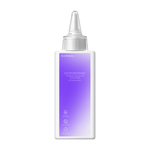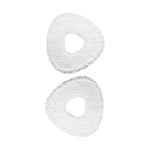Vacuuming cat litter may seem like a quick fix, but it can damage your vacuum, spread bacteria, and leave behind lingering odors. If you're wondering whether it's safe to vacuum cat litter—or what tools actually work—this guide gives you a clear, practical answer.
We’ll first explain why regular vacuums aren't designed for cat litter and how scattered messes can be avoided from the start. Then we’ll explore the best vacuum types for this job, step-by-step instructions for safe vacuuming, and reliable alternatives if you'd rather skip the vacuum altogether.
Finally, we’ll highlight two top-performing solutions trusted by pet owners: a fully automated robot vacuum for hands-free cleaning, and a powerful wet-dry vacuum for tackling litter clumps and spills in one pass. Whether you're preventing a mess or cleaning one up, you'll find the right approach for a cleaner, healthier home.
Why Vacuuming Cat Litter Can Be Risky
Vacuuming cat litter with a regular vacuum can cause serious damage and health issues. Most standard vacuums are not designed to handle abrasive particles, moisture, or fine dust from cat litter. Here's why it's not recommended:
-
Abrasive particles: Clay and silica-based litter can scratch internal vacuum parts like hoses and filters, leading to long-term wear.
-
Clumping hazards: When cat litter mixes with urine, it forms hard clumps that can block the vacuum hose and reduce suction power.
-
Hardened debris: Dry clumps may become as hard as small rocks, risking damage to the vacuum motor and brushes.
-
Filter blockage: Fine dust from litter can quickly clog filters, lowering vacuum efficiency and risking overheating.
-
Odor build-up: Litter residue left inside the vacuum can release bad smells each time the device is used.
-
Moisture damage: Wet litter introduces moisture that can harm electrical parts and encourage mold growth inside the vacuum.
-
Bacterial spread: Cat feces and urine may contain bacteria. Vacuuming them can circulate harmful particles into your living space.
-
Shorter vacuum lifespan: Regularly cleaning litter with a standard vacuum leads to cumulative damage and shortens its useful life.
-
Difficult maintenance: Removing stuck litter from hoses and filters is messy and time-consuming, often requiring disassembly.
-
Poor performance: Standard vacuums struggle to pick up litter completely, leaving behind dust and debris that still need manual cleaning.
How to Prevent Cat Litter Mess
Litter scatter is a common issue in homes with cats, but it often starts with how the litter area is set up. With the right setup and a few simple habits, you can reduce litter mess before it happens. In this section, we’ll cover practical ways to keep cat litter contained, including box placement, accessories, and daily routines.
Use a High-Sided Litter Box
Cats tend to dig and kick, which sends litter flying out of the box. A litter box with high sides helps block the mess and keeps the litter in place.
Place a Mat Under the Box
Litter often sticks to your cat’s paws. A textured litter mat placed at the entrance of the box can catch particles before they’re tracked around your home.
Scoop Daily
Scoop the litter box at least once a day. A clean box prevents buildup, reduces odor, and helps discourage your cat from over-digging or scratching at the edges.
Position the Box in a Corner
Placing the litter box against two walls helps limit the direction litter can scatter. Corners also give your cat a sense of privacy, which may reduce anxious digging.
What Kind of Vacuum Works for Cat Litter
Not all vacuums can clean cat litter effectively. To avoid clogging, damage, or dust blowback, you need the right type of vacuum. In this section, we’ll compare bagged vs. bagless models, explain why HEPA filters matter, and highlight features to look for in pet vacuums.
Bagged vs. Bagless Vacuums
Bagged vacuums are generally safer for cleaning cat litter. The sealed bags trap dust and fine litter particles, keeping them away from the motor and filters. This helps reduce the risk of clogging and extends the life of the machine.
Bagless vacuums may be more convenient, but their cyclone systems often struggle with the dense, gritty texture of litter. Fine dust can settle inside the vacuum chamber, making cleanup harder and increasing wear on internal parts.
Importance of HEPA Filters
A vacuum with a high-efficiency particulate air (HEPA) filter is essential for cleaning up litter. These filters trap tiny particles and help prevent litter dust from being released back into the air. This is especially important if you have allergies or want to keep your home environment clean and odor-free.
Specialized Pet Vacuums
Some vacuums are specifically designed for pet owners and offer stronger suction, tangle-free brushes, and sealed systems. These models are often more effective at picking up cat litter, pet hair, and dander. When possible, choose a vacuum marketed as “pet-friendly” or “multi-surface” with features like self-cleaning filters or washable components.
How to Vacuum Cat Litter the Right Way
Vacuuming cat litter safely requires the right steps and tools. Done incorrectly, it can harm your vacuum or make the mess worse. This guide walks you through how to prepare your vacuum, use proper attachments, avoid clumps, and maintain your vacuum after cleaning.
Step 1: Prepare Your Vacuum
Before you start, make sure the vacuum is ready. Empty the canister or replace the bag to provide maximum airflow. Check that filters are clean and properly installed. This helps improve suction and reduces the chance of litter buildup inside the machine.
Step 2: Use the Right Attachment
Choose a wide, flat nozzle without a motorized brush. Avoid using crevice tools or narrow openings that can get jammed. A basic floor attachment is best for collecting litter while reducing the risk of clogs.
Step 3: Vacuum Small Amounts Only
Never try to vacuum a large pile of litter at once. Start by sweeping up most of the mess with a broom or dustpan. Then, use the vacuum to collect the remaining dust and fine particles. This prevents overloading the vacuum and keeps the filter clear.
Step 4: Avoid Wet or Clumping Litter
Only vacuum dry litter. Moist or urine-soaked clumps can harden inside the hose and cause blockages. If the area around the litter box is damp, dry it first before using your vacuum.
Step 5: Clean the Vacuum After Use
When you’re done, empty the bin or replace the bag immediately. Wipe down any attachments and clean the filters as recommended by the manufacturer. This prevents litter dust from accumulating inside and helps maintain long-term vacuum performance.
Better Ways to Clean Cat Litter Without a Vacuum
If you don’t want to vacuum cat litter or don’t own a pet vacuum, there are other ways to keep your floors clean. From simple tools like brooms to smart solutions like robot litter boxes and air purifiers, these alternatives can help reduce mess and make cleanup easier.
Manual Tools
These classic solutions are affordable, easy to use, and effective for daily cleanup.
-
Broom and dustpan: Great for sweeping up scattered litter quickly. Choose a stiff-bristle broom to collect even heavy granules.
-
Litter scoop with bag: Scoop out clumps and dispose of them in a sealed bag to reduce odor and prevent buildup.
Containment Aids
Prevent litter from spreading with tools that catch messes before they hit the floor.
-
Litter mat: Placing a textured mat under the litter box helps trap loose particles stuck to your cat’s paws.
-
Litter box enclosure: Enclosed boxes or furniture-style enclosures help block flying litter and keep the area tidier.
Smart Upgrades
For a cleaner and more convenient routine, consider these hands-free or automated options.
-
Robot litter box: These devices automatically sift waste and help control odor, reducing how often you need to scoop.
-
Air purifier: While not directly cleaning litter, an air purifier helps remove litter dust and unwanted smells from the air.
Best Vacuums for Cat Litter: Narwal Solutions
Cleaning cat litter shouldn’t feel like a never-ending chore. Whether you're dealing with scattered grains, dried messes, or muddy paw prints, these two Narwal vacuums are designed to make pet cleanup easier, cleaner, and less stressful.
Narwal Freo Z10 Ultra Robot Vacuum and Mop
Best for: Pet parents who want a fully hands-free, smart cleaning assistant that keeps the litter zone spotless—even when you're not home.
[cta:narwal-freo-z10-ultra-intelligent-in-mind-deep-in-clean]
Scattered litter in corners, tracked paw prints on tile, and surprise spills when you're not around—this robot handles it all on its own. The Freo Z10 Ultra doesn’t just vacuum and mop. It sees, thinks, and adapts.
-
Targets messes on its own: Dual cameras and AI help it spot litter near the box and steer around pet bowls, toys, or accidents without needing your help.
-
Cleans all the way to the edges: The EdgeReach™ triangular mop extends and twists into corners, making sure no litter or grime is left hiding along the wall.
-
Knows what it's cleaning: Wet paw prints? Dry litter? It adjusts automatically—no switching modes, no guesswork.
-
No more dirty pads or filters: It washes the mop in hot water (up to 167°F), then dries it—meaning no stink, no mildew, no touching the mess.
-
No daily maintenance: It empties itself into a sealed bag that lasts up to 120 days.
If you’ve ever wished the floor around the litter box would clean itself, this is the closest it gets.
Narwal S30 Pro Wet Dry Vacuum
Best for: Cat owners who want precise, powerful control over messes—especially wet spills, stuck-on grime, and scattered litter.
[cta:narwal-s30-pro-wet-dry-vacuums]
Some messes need instant cleanup, and this is the vacuum that’s built for them. The S30 Pro gives you full control, yet makes everything feel light and easy.
-
One-pass cleanups: Sticky litter clumps, spilled water, and cat food are gone in a single swipe—with 20,000Pa suction and steady pressure doing the heavy lifting.
-
Handles hair without tangles: Built-in scissors cut through tangled hair, and a dual comb clears it away—so you never have to pull out stuck strands.
-
Reaches every tricky spot: Flat enough to glide under furniture, and precise enough to clean right up to baseboards and corners where litter often hides.
-
Fresh mop, every time: It rinses itself with hot water and detergent, then dries completely at 194°F—no smell, no mildew, no mess left behind.
-
Truly hands-free waste disposal: Dirty water and debris are sealed in separate containers, and the bag is designed to toss without touching a thing.
For pet owners who want quick wins and deep cleans—without fighting tangles or touching the mess—the S30 Pro makes it almost effortless.
Effortless Cat Litter Cleanup with the Best Vacuum Solutions
Cleaning up cat litter no longer has to be messy, time-consuming, or frustrating. With the right vacuum, you can remove dry debris, tackle sticky clumps, and wipe out odor-causing messes—all with minimal effort. That’s exactly why thousands of pet owners trust Narwal Australia.
Our best-selling models are engineered with real homes and real messes in mind. The best robot vacuums for cat litter handle everything automatically—perfect for busy pet parents who want to stay hands-free. Prefer to clean with precision? The best wet and dry vacuum cleaners for cat litter give you total control over wet and dry messes alike, all in one smooth pass.
As Australia’s top choice in smart cleaning, Narwal not only delivers advanced technology, but also supports flexible payments with Afterpay, Zip, and Klarna. That means a cleaner home, smarter cleanup—and no upfront stress.
Ready to upgrade how you clean? Narwal has you (and your litter box area) covered.























































